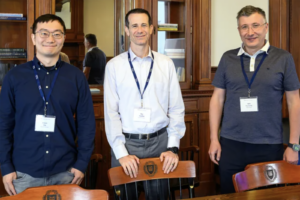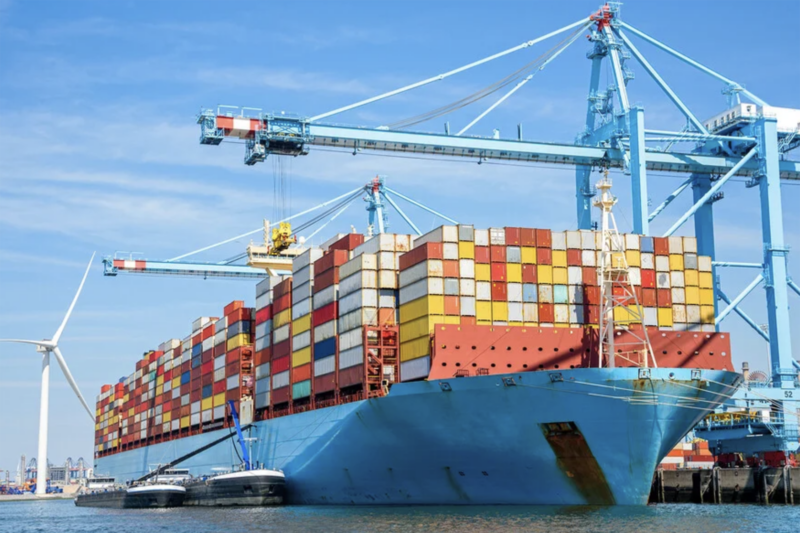In a Q&A, Jackson professor Aleh Tsyvinski and fellow researchers explain how they are engaging with business leaders on policy-relevant research to make supply chains more efficient and resilient.
In recent years, the words “supply chain issues” have emerged as a familiar explanation for the inability of families and businesses in the U.S. and elsewhere to access certain goods, from toilet paper to computer chips.
The COVID-19 pandemic and its related shortages were likely the first time many American consumers had really considered supply chains — the complex networks through which products are created and distributed. They weren’t alone. Historically, outside of business schools, supply chains have generated little general interest even from academic economists, says Aleh Tsyvinski, Arthur M. Okun Professor of Economics and Global Affairs.
During a recent conference hosted by Yale’s Tobin Center for Economic Policy and the Cowles Foundation for Research in Economics (and organized by Tsyvinski and Princeton economist Ernest Liu), experts from academia and the business world discussed how research can support efforts to predict, avoid, and manage supply chain disruptions. The conference featured a keynote by Benjamin Gordon, a Yale graduate who is managing partner and CEO of Cambridge Capital and a leading advisor to, and investor in, supply chain companies.

Tsyvinski and Liu, with support from the Tobin Center, are developing a novel platform that offers highly detailed information on supply chain disruptions in near-real time across a range of products, industries, and localities.
The project offers first-of-its-kind insight into the granular functioning of supply chains that can benefit policymakers and the private sector, said Tsyvinski.
The Tobin Center also is supporting The Supply Chain Research Alliance, a project by economists at Yale, the London School of Economics, and MIT to identify management practices that make supply chains more efficient and resilient.
During the recent conference, Tsyvinski, Liu, and Gordon participated in a Q&A to explain the importance of supply chains to the global economy and how business and academia can join forces to strengthen them. The scholars also offered a glimpse of their platform monitoring supply chain activity.
What are the goals of this conference and the supply chain initiatives that the Tobin Center is supporting?
Tsyvinski: Supply chains are a critical issue for the functioning of the U.S. economy, and the Cowles Foundation and Tobin Center are well positioned to combine cutting-edge economic theory with state-of-the-art data analysis to inform policies aimed at strengthening them. The Tobin Center can help us connect with policymakers so that our academic work has real-world impact.
This conference, and Tobin’s wider supply chain initiative, are intended to focus the attention of a new generation of scholars on questions concerning supply chains. We want to emphasize that this is a topic of central importance to scholars interested in public policy and those interested in theoretical questions — as well as to business leaders, like Ben [Gordon], whose firms focus on well-functioning supply chains.
Typically, in economics, theory takes years, even decades, to trickle down to policy. This is one of the very few examples where the distance between the cutting-edge theory, cutting-edge data analysis, and practical applications are very short. Current research, including the papers presented at our conference, address issues that the International Monetary Fund and World Bank, international trade organizations, central banks, and firms are grappling with today.
How have supply chains evolved from the Industrial Revolution to the present day?
Gordon: Over the last 150 years or so, innovations to supply chains have powered three waves of economic, social, and geopolitical change. In 1869, Leland Stanford drove the Golden Spike into the ground at Promontory Summit in Utah, completing the first transcontinental railroad. This meant that, for the first time, you could ship high volumes at low cost from one end of the U.S. to the other, which fueled all kinds of economic growth, especially on the West Coast.
In 1956, American businessman Malcolm McLean developed containerization. He figured out that you could stack containers onto converted oil tankers to ship a step function increase of more goods at lower cost than ever before. McLean’s innovation enabled companies to create new ways of manufacturing and distributing. Without containerization, there is no Walmart. Our modern economy depends on this breakthrough.
The third wave of supply chain breakthroughs began around 2000 with the emergence of the digital supply chain. Amazon embodies this wave. Today, we can buy goods anywhere in the world and a digital supply chain instantly links sourcing, fulfillment, tracking, last mile delivery, and returns.
Supply chains are like a giant iceberg: They mostly sit under the surface, undetected and overlooked. As a Yale undergraduate, I never studied supply chains. There was no supply chain program. But I ended up starting a series of companies, and supply chains became a critical part of what I do. Now more than ever, students benefit from understanding how supply chains work. This fundamental knowledge base sits at the intersection of engineering, innovation, operations research, public policy, and other core disciplines. I believe students should learn this field to better understand the 21st century world, whether through a core undergrad curriculum or through more specialized grad-level programs.
What drives the new interest in supply chains from academic economists?
Liu: I think that three things are fueling this new interest in supply chains. One is the ability of economists to think about complex interactions across firms or across countries from a network perspective — a capacity we have developed over the past decade. Second is the wide availability of data. Today, we can access firm-to-firm data as well as massive amounts of shipping data, which opens all kinds of avenues for empirical research. The third is geopolitical. Recent supply-chain disruptions and related inflation have generated a lot of interest in the topic from governments across the globe.
At this conference, we had a remarkably diverse group of people analyzing this very important policy issue that relates to geopolitics and trade, and monetary and industrial policy. There were macroeconomists analyzing inflation and macroeconomic theorists thinking about a very abstract modeling. We also had empiricists analyzing data. It’s a very exciting topic to study.
How can business and academia work together to improve supply chains?
Gordon: I see several potential areas for productive interactions between academia and the business world. One example is dynamic or predictive pricing. Anyone who has shopped for airline tickets knows that the prices fluctuate from one day to the next. Airlines have become proficient at changing prices instantly to optimize supply and demand. However, predictive pricing isn’t used in other areas of the supply chain. The trucking industry still functions in a world that was shaped by fixed pricing … That’s a problem because we live in a world where there’s more volatility in supply chains than ever before, making it more important than ever to have dynamic pricing tools at your disposal.
I co-founded a company called Greenscreens.ai that applies artificial intelligence to trucking. We could share our data to collaborate with scholars who are interested in this field. For instance, together we could quantify the value of dynamic pricing and think about other areas where we could apply it. How do you train data models to predict prices more accurately? This research could remove volatility from supply chains, which is good for consumers, producers, suppliers, and all involved. This is just one example where new technologies and advanced economic modeling can make a major impact on supply chains.
Tsyvinski: Ben’s example nicely illustrates the importance of combining business and academic perspectives. If you want more accurate predictive pricing, you need industry-level expertise as well as cutting-edge analytics and expertise on macroeconomic factors, such as what’s happening with international trade and port congestion, which typically falls outside the know-how of individual firms.
In academia, we tend to be heavily focused on the universality of the concepts and relationships we study, which leaves us lagging in terms of our ability to analyze firm-level decision making. We are trying to bridge the gap by bringing the two perspectives together. Hopefully, this will help the businesses answer questions relevant to them. At the same time, we hope it will move academia from its echo chamber and keep us informed of the most relevant and important decisions being made by folks on the cutting edge of industry. It’s about people operating on two different frontiers working together synergistically, which is very exciting.
Can you talk a little about the platform you’re developing with Vladimir Smirnyagin of the University of Virginia to identify and measure supply chain disruptions?
Tsyvinski: In policymaking, there’s a dictum that you cannot address something that you cannot measure. We talk about supply-chain disruptions, but how do we measure them? How do we know when supply disruptions are hitting the U.S.? There are some indices to track global supply disruptions, but they are basically based on the cost of shipping a container from one place to another. And if you are interested in the question of whether toys or furniture are disrupted, it can be hard to know. How about critical supplies? The U.S. government has a list of critical goods, including magnets, large-capacity batteries, pharmaceuticals, various minerals and raw materials, and so on. What is the disruption there?
We’ve analyzed about 200 million datapoints concerning literally every container coming into the U.S. Analyzing this super-detailed data with state-of-the-art computer modeling allowed us to create a sweeping monthly index of supply-chain disruption — interruptions in the production, sale, or distribution of products. In close to real time and with an unprecedented level of granularity, we can measure disruptions across industries, products, and localities. We can identify whether magnets are more disrupted than toys. We can provide detail on which kinds of toys are being disrupted. At the firm level, we can show whether an individual company, say American Airlines, faces more disruptions than another firm. We can also show whether it is American Airlines being disrupted or one of its subsidiaries. We can do this for every major company in the U.S. We can also track the temporary breakdowns in the long-term supplier, manufacturer, and customer relationships. And, crucially, we can identify and measure disruptions to critical supplies.
I give great credit to my colleagues, Ernest and Vladimir, for figuring out how to do this.
Liu: We publish a report of all U.S. activity on the 16th of every month. We also publish reports for individual sectors and for critical supplies, which is a big lift because there is a long list of critical supply products that differs across industries. As Aleh emphasized, the data is incredibly granular. If you imported furniture from France, we can identify the individual who sent it to you. It’s our hope that having this timely and very detailed data will benefit businesses and inform policymakers.
